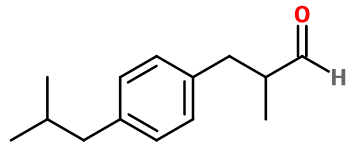Silvial®
Synthétique
Floral > Light Flowers > Aldehydic > Aquatic

Crédits photo: ScenTree SAS
Other names :
Alpha-methyl-4-(2-methylpropyl) benzenepropanal ; Para-isobutyl-alpha-methyl hydrocinnamaldehyde ; Aldéhyde para-isobutyl-alpha-methyl hydrocinnamique ; 3-(4-isobutylphenyl)-2-methylpropanal ; 3-(para-cumenyl)-2-methyl propionaldehyde ; Cyclamen homoaldehyde ; Homoaldehyde cyclamen ; 2-methyl-3-(4-(2-methyl propyl)phenyl) propanal ; Rhodial ; Suzaral
Volatility :
Heart
Uses in perfumery :
Silvial® is usually used to replace regulated aldehydes as Lilial® or Lyral® in lily of the valley accords for example. It brings a powerful and fresh note, with a floral identity.
Natural availability :
Sylvial® is not found in nature. Thus, it is not extracted from any plant.
Year of discovery :
Patent N°1.430.164 (FR) published on Nov.13, 1964 by Rhône-Poulenc company
Other comments :
Sylvial® has a structure close to Lilial®, Cyclamen Aldehyde®, Bourgeonal® and Florhydral®. Eac of these molecules have a light flower smell, with a more marine nuance for Cyclamen Aldehyde®, greener for Bourgeonal® and fruitier for Florhydral® for example.
Price Range :
€€
Stability :
Very unstable in stong acidic (detergents) and alkaline (liquid bleach) bases. Stable in other types of bases.

Crédits photo: ScenTree SAS
- Molecular formula :
- C14H20O
- Molecular Weight :
- 204,31 g/mol
- Density :
- 0,94
- Flash Point :
- 120°C
- Fusion Point :
- Donnée indisponible.
- Appearance :
- Colorless liquid
- Log P :
- 4,7
- Boiling Point :
- 245°C
- Detection Threshold :
- 0,7 ng/L air
Synthesis route :
As it has a structure close to Lilial® and Cyclamen Aldehyde®, the synthesis of Silvial® can be made in two different ways. The first one consists in a condensation of two aldehydes : 4-isobutylbenzaldehyde and Acetaldehyde, using an excess of the first reagent, and adding the second one slowly, to prevent autocondensation of Acetaldehyde. Then, a catalytic hydrogenation of the obtained product leads to Silvial®. The second synthetic route is a Friedel and Craft reaction involving isobutylbenzene and Methacrolein diacetate, followed by subsequent acidic hydrolysis of the intermediary product.
Synthesis precursor :
Reacting with Methyl Anthranilate, Silvial® can help synthesizing its Schiff base, although it is very poorly used.
Isomerism :
Silvial® has one asymmetric carbon. Nevertheless, a mixture of these two molecules is used in perfumes. Also, ortho and meta isomers of Silvial® are not used in perfumery. Eventually, Lilial® is a positional isomer of Silvial®. Its smell is fresher and fruitier, and less aqueous.
- EINECS number :
- 229-695-0
- FEMA number :
- Donnée indisponible.
- JECFA number :
- Donnée indisponible.
- FLAVIS number :
- Donnée indisponible.
- Allergens :
- This ingredient does not contain any allergen.
- IFRA :
- This ingredient is restricted by IFRA
- Restriction type :
- RESTRICTION
- Cause of restriction :
- DERMAL SENSITIZATION AND SYSTEMIC TOXICITY
- Amendment :
- 49
- Quantitative limit on the use :
-
Cat.1 Cat.2 Cat.3 Cat.4 Cat.5A Cat.5B Cat.5C Cat.5D Cat.6 0,08 % 0,053 % 0,8 % 0,99 % 0,25 % 0,25 % 0,25 % 0,083 % 0,08 % Cat.7A Cat.7B Cat.8 Cat.9 Cat.10A Cat.10B Cat.11A Cat.11B Cat.12 0,72 % 0,72 % 0,083 % 1,9 % 1,9 % 5,4 % 0,083 % 0,083 % No Restriction - Restriction type :
- RESTRICTION QRA
- Cause of restriction :
- Amendment :
- 44
- Quantitative usage limits :
-
Cat.1 Cat.2 Cat.3 Cat.4 Cat.5 Cat.6 Cat.7 Cat.8 Cat.9 Cat.10 Cat.11 0,07 % 0,08 % 0,35 % 1,04 % 0,55 % 1,67 % 0,17 % 2 % 5 % 2,5 % Not Restricted
To learn more about IFRA's standards : https://ifrafragrance.org/safe-use/library
ScenTree is solely responsible for the information provided here.

